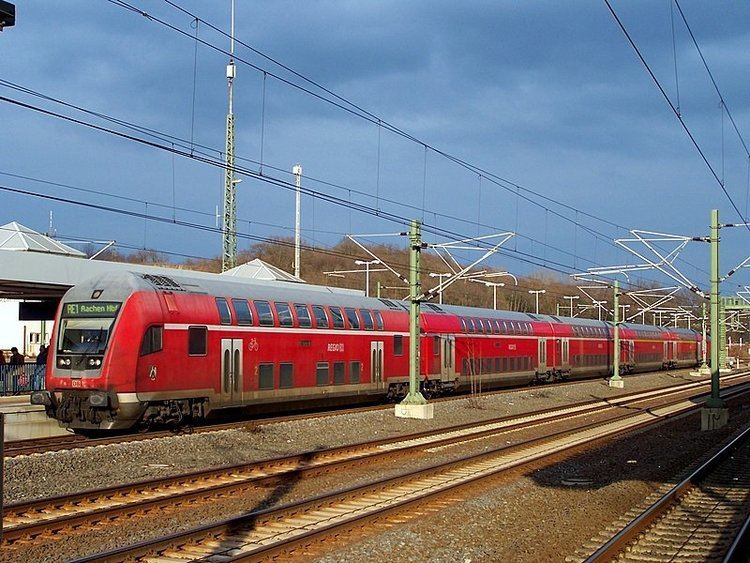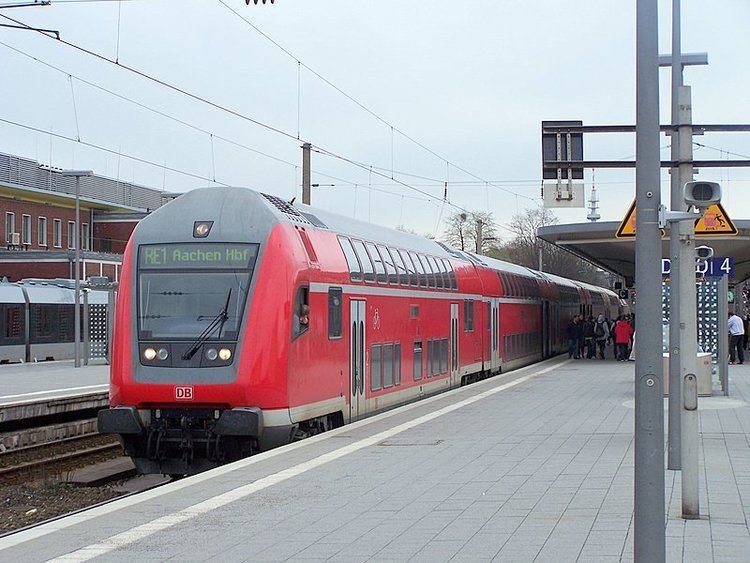Line length 296 km (184 mi) | 0 Aachen Hbf | |
 | ||
Operating speed Route number 480 (Aachen–Köln)415 (Köln–Hamm)430 (Hamm–Warburg) | ||
Train simulator 2015 pc gameplay full hd nrw express von k ln hbf nach d sseldorf hbf
The NRW-Express is a Regional-Express service in the German state of North Rhine-Westphalia (NRW), running from Aachen via Cologne, Düsseldorf, Essen and Dortmund to Hamm as line RE 1. The line is operated by DB Regio NRW.
Contents
- Train simulator 2015 pc gameplay full hd nrw express von k ln hbf nach d sseldorf hbf
- Nrw express re 1 in duisburg hbf
- History
- Route
- Other services
- Public transport associations
- Future
- References

The service has one of the highest levels of patronage in Germany with about 110,000 passengers per day, mainly commuters and students.

Nrw express re 1 in duisburg hbf
History

Today's NRW-Express replaced existing express services on individual sections of the route after the regionalisation of transport in Germany. A number of stations previously served by long-distance trains, such as Düsseldorf-Benrath and Wattenscheid came to be served by regional services only. The NRW-Express was first classified as Regionalschnellbahn ("regional fast train") RSB 1, then as StadtExpress ("city express") SE 1 and eventually as Regional-Express RE 1, when it was also given the name of NRW-Express.

The service originally operated on the Aachen–Bielefeld route and was composed of class 110 locomotives hauling six partly modernised Silberling carriages. If necessary, trains had an additional carriage. From the mid-90s, the trains were formed of non air-conditioned double-deck carriages and class 111 locomotives. Shortly later control cars were added, so that push–pull operations could be introduced. From 1998, air-conditioned double-deck carriages were introduced, but only after Expo 2000 in Hanover were all services of the NRW-Express operated with new air-conditioned carriages equipped to operate at 160 km/h. The sets were now mostly hauled by class 146 locomotives, which had originally been supplied for the Expo.
The class 145 locomotives, with their AC engines, had performed well on services at Expo 2000, so their introduction on the NRW-Express services was hoped to improve on-time running with their better acceleration. A passenger version of class 145, which has a top speed of 140 km/h, was ordered as class 146 with a top speed of 160 km/h in the autumn of 2001 and was first used for the NRW-Express services.
RE 1 provided travel times that were very competitive with long-distance trains through North Rhine-Westphalia and had good connections in Bielefeld to Hanover, so the train on weekends was heavily used by long-distance travellers to Hamburg and Berlin as part of the so-called Wochenend-Ticket-Rennstrecke ("weekend-ticket race track"). This attractiveness became a problem since the trains were often overcrowded. An extension of the trains with an additional carriage failed to overcome this problem because the trains still used single-deck carriages and some platforms were too short for the extra carriage. At the time double-deck carriages were in short supply and their increased weight caused travel times to be extended (only during a few timetable periods were services formed with six double-deck carriages). The high loadings often meant that the scheduled stopping times were insufficient, so delays were created. Delays to long-distance trains also had a strong influence on the punctuality of the NRW-Express. The situation was aggravated several times when DB Regio tried to change the timetable by shortening the turnaround time in Bielefeld from 70 to 10 minutes to save a train set. These trials were always given up after a few weeks at the most.
With the timetable change in December 2002, the route was cut back from Bielefeld to Hamm. On the section that was eliminated, the NRW-Express was replaced by the newly created Westfalen-Express (RE 6) from Düsseldorf via Duisburg, Essen, Hamm and Bielefeld to Minden. On the last section from Dortmund, the NRW-Express, however, now stopped only in Kamen, except every second hour it stopped at all five stations on the section. As a result of the shortening of the route of the trains, punctuality was significantly improved, although in the past most lost time could be made up between Hamm and Bielefeld. RE 1 therefore remains one of the lines in North Rhine-Westphalia that is most vulnerable to delay.
A bomb plot on the train in 2006 failed due to faulty construction.
Since the timetable change in December 2010, services have been extended every 2 hours to run between Hamm an Paderborn. In the off-peak it also stops only at Dortmund-Scharnhorst, Dortmund-Kurl, Kamen-Methler and Nordbögge. The first morning service to Paderborn stops at all stations between Hamm and Paderborn.
A sixth carriage was gradually introduced on each train between March 2011 and September 2011. This increased the capacity from 602 to 735 seats per train.
The section between Hamm and Paderborn was dropped in December 2016.
Route
The NRW-Express operates daily between Aachen and Hamm. He used it a total of four railway lines :
In the four to six track section between Duisburg and Düsseldorf, the NRW-Express runs throughout on the long distance tracks, along with the Rhein-Express (RE 5). By contrast, the Rhein-Haard-Express (RE 2), the Rhein-Emscher-Express (RE 3), the Rhein-Weser-Express (RE 6), the Rhein-Hellweg-Express (RE 11) and the Rhein-IJssel-Express (RE 19) run on the S-Bahn tracks or. if available, the so-called local tracks.
Earlier, the NRW-Express used two other railway lines:
Other services
The NRW-Express is complemented by other rail passenger services. A large portion of it runs parallel to S-Bahn lines. The following Regional-Express services run every hour along part of its route:
Additional services operate during the peaks between Aachen and Cologne Messe/Deutz five minutes before the regular services in order to overcome overcrowding.
The NRW-Express is linked in Aachen, Cologne, Düsseldorf, Duisburg, Essen, Dortmund, Hamm and Paderborn with the whole transport network of North Rhine-Westphalia. It also has direct connections at these stations with long-distance passenger services.
Public transport associations
Three public transport associations are involved in the operation of the Rhein-Express: the Zweckverband Nahverkehr Rheinland (local transport association of Rhineland, NVR), Verkehrsverbund Rhein-Ruhr (transport association of the Rhine-Ruhr, VRR) and the Zweckverband Nahverkehr Westfalen-Lippe (local transport association of Westphalia-Lippe).
Future
A reorganisation of services is planned in 2020 between Cologne and Dortmund, under the program known as the Rhine-Ruhr Express (RRX).
Within the framework of the so-called RRX interim contract, the services are to be operated by DB Regio from 2016 until the RRX rolling stock are commissioned in 2018. Following this, Abellio Rail NRW will take the operations because it won the contract.
